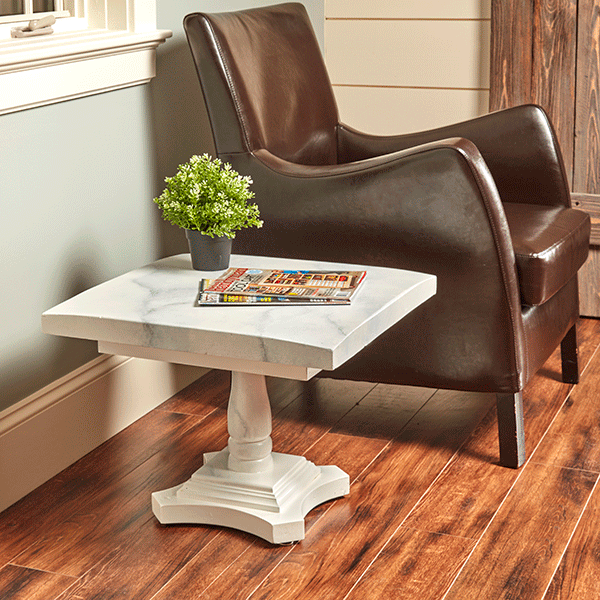Make old furniture feel new and luxurious with this easy-to-do painting technique!
A full day
Beginner
$51–100
Introduction
One of the easiest and most impactful ways to update old furniture is to paint it. And you can take it up another notch by adding a decorative faux marble finish. While this project looks difficult, it's actually quite basic-you just need some paint, a handful of tools and a smidgen of patience. The following steps will show you how to paint a faux Carrara marble table.This side table circa the 1970s cost just a few dollars at a garage sale. While not much to look at, it’s sturdy and solid. With a little bit of paint, though, it will look great.
Sponging white back into the marble pattern is a secret weapon! It allows you to easily fix mistakes, highlight curves and break up too-dark veins. Remember to dry-brush any areas that you sponge to blur the colors.
There’s also no need to let the layers dry fully while creating your marble look with paint; it’s easier to blend if the paint is still a bit wet. You don’t want harsh, cartoonish lines here; instead, try for softer veins that come naturally.
Project step-by-step (11)
Sand the surface
Sand the table to remove the old finish and smooth out any imperfections in the wood. Wipe off the dust with a damp cloth.

Apply primer
Apply at least two even coats of white paint and primer in one. Let the white base dry completely.

Mix Paint Colors
Mix white and black paint in separate containers to create two different shades of gray. Also, keep a small container of the white nearby. Add a couple of teaspoons of water to all colors to thin them out.
Sponge on white
Use a slightly damp sea sponge to apply a light layer of white all over the table.

Brush on large gray veins
Next, use a medium-size paintbrush to place the lightest gray color in various large areas.

Sponge over gray
Sponge over the gray to create a smoky look. Then, sponge white randomly on top of the gray.
Blend out gray
Use a dry blending brush to smooth out the sponged colors. Repeat this process once more.

Create fine veins
Use a very small paintbrush and a darker shade of gray to create more precise veins.
Sponge over fine veins
Immediately after placing the paint, use the sponge to go over each vein (you can add a little white, if you desire).
Blend out fine veins
Use a dry blending brush to smooth out the fine veins. Repeat this step at least two times, and add in some white veins to create highlighted areas. When you’re satisfied, allow the paint to dry for several hours.
Apply coats of polyurethane
Finally, apply two coats of clear, water-based polyurethane with a satin finish. Allow the table to dry completely for 24 hours before using it.






















